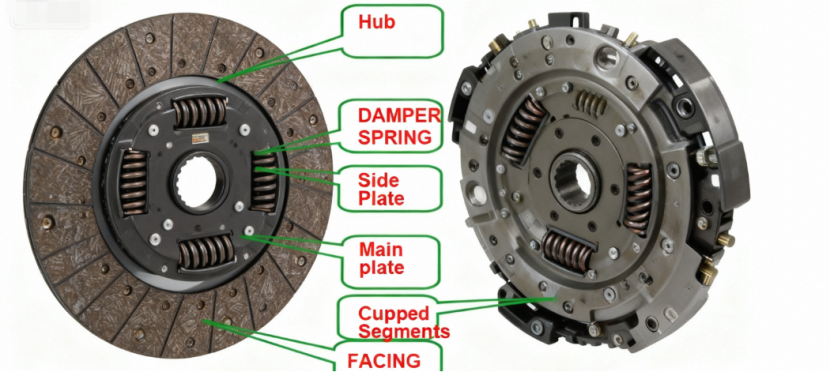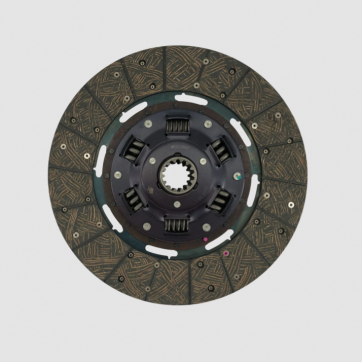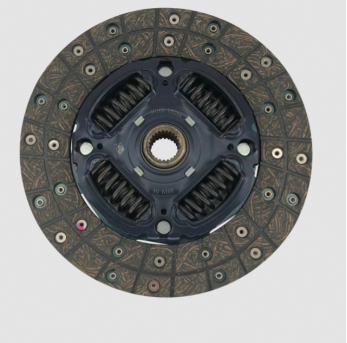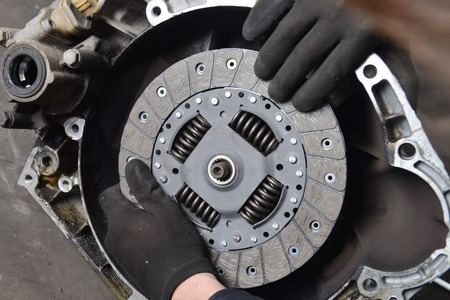|
|
A car is composed of tens of thousands of parts that work precisely together. Some car parts, such as engines and gearboxes, are well-known and familiar to everyone. While others might be unknown to everyone, they play a very significant role. It is not until they "go on strike" that we realize how important they are. The clutch disc is precisely such a crucial "silent guardian". It is not only an important part of manual transmission vehicles, but also the key to understanding the principle of vehicle power transmission. This article will give you a detailed explanation: What is a clutch plate? How does it work? Why is it damaged? And how to use and maintain it correctly in order to extend its service life and ensure your smooth and safe driving.
1.What is a clutch disc?
If you want to know what a clutch disc is, the following video about clutch discs from longwind manufacturer can give you a general understanding first. Let's take a look together:
It seems that we can briefly summarize the above matter: The clutch disc is the core friction component in the automotive clutch assembly, and its core mission is to be responsible for the "connection" and "disconnection" of engine power to the transmission.
You can imagine it as a "switch" for power transmission, located between the engine flywheel and the pressure plate. It is a disc-shaped component composed of friction materials, adhesives, reinforcing materials, etc.
Structural analysis: Typical clutch discs usually include:
Friction lining: Attached to both sides of the core plate, it is the part that directly contacts and generates friction with the flywheel and pressure plate. It is usually made of asbestos-based, semi-metallic, organic or ceramic materials and features a high coefficient of friction and heat resistance.
Main plate (carrier plate) : Usually made of metal, it serves to support and structure the main body.
Torsional shock absorber: The spring structure built into the core plate can absorb the torsional vibration transmitted by the engine, making the power connection smoother and protecting the transmission gears.
Spline hub: The central toothed structure meshes with the splines of the input shaft of the transmission and is responsible for transmitting power to the transmission.
In automatic transmission vehicles, although the traditional clutch disc structure has been replaced by hydraulic torque converters and the like, in dual-clutch transmissions, the core of gear shifting still consists of multiple sets of high-performance clutch discs.

2.The working principle and process of the clutch system
To understand the function of the clutch disc, it must be viewed within the context of the entire clutch system. This system is mainly composed of a clutch pedal, a release bearing, a pressure plate, clutch discs and a flywheel.
Its working process can be compared to holding a rotating sandpaper between two palms:
Engagement state (power transmission) :
When your foot leaves the clutch pedal, the pressure plate, under the strong pressure of the diaphragm spring, tightly presses the clutch disc against the high-speed rotating engine flywheel.
At this point, due to the huge frictional force, the flywheel, clutch disc and pressure plate are "locked" into one whole and rotate synchronously.
Power is transmitted to the input shaft of the transmission without any loss through the spline hub of the clutch disc, ultimately driving the wheels forward. At this moment, the clutch disc is enduring tremendous pressure and friction in "silence".
Separation state (power interruption) :
When you step on the clutch pedal, the release bearing is pushed forward towards the diaphragm spring tip of the pressure plate through the hydraulic or pull wire mechanism.
The diaphragm spring deforms, and its outer ring drives the pressure plate to move backward, thereby releasing the pressure on the clutch disc.
At this point, the flywheel and pressure plate are still rotating with the engine, but the clutch disc has been "liberated" and stopped rotating. The power connection between the engine and the transmission is cut off. At this point, you can shift gears or stop smoothly. This process is a brief "rest" moment for the clutch disc.
Semi-linked state (precise control):
This is the essence of driving a manual transmission car and also the condition that causes the most wear and tear on the clutch discs.
When you slowly lift the clutch pedal, the pressure exerted by the pressure plate on the clutch disc gradually increases. The clutch disc is in a "close yet distant" state with the flywheel and pressure plate, and there is relative sliding friction.
By controlling the degree of sliding friction, the smooth transmission of part of the engine power can be achieved, enabling the vehicle to start smoothly, pass through congested sections slowly or complete precise reversing into a parking space. At this moment, the clutch disc is performing its most delicate duties in "friction".


3.Common symptoms of clutch disc damage
clutch discs are consumables, and their lifespan is closely related to driving habits and driving conditions. When the following symptoms occur, it is very likely that your clutch discs have worn to the limit and need to be inspected and replaced in time:
Clutch slip (power loss) :
Performance: The engine speed rises rapidly, but the vehicle speed increases slowly. It feels especially weak when going uphill. In severe cases, a burnt smell can be detected.
The reason: the friction plate is excessively worn and thinned, and the pressure plate cannot fully press it against the flywheel, resulting in incomplete power transmission and relative sliding.
Difficulty in shifting gears or abnormal noise:
Symptoms: Severe gear impact during gear shifting, making it difficult to shift into a gear, or accompanied by a "creaking" sound.
Reason: the clutch was not completely disengaged, and the power was not completely cut off, causing the input shaft of the transmission to continue rotating and generating impact when meshing with the stationary gears.
Clutch vibration:
Manifestation: When the vehicle starts, the body experiences irregular and severe shaking.
The reason is that the friction material on the surface of the clutch disc hardens, erodes or wears unevenly due to long-term high temperature, resulting in an uneven contact surface and fluctuating friction torque, thereby causing vibration.
The clutch pedal feels abnormal:
Symptoms: The pedal travel becomes longer and heavier, or feels soft and weak.
The reason might be that the wear of the clutch disc causes changes in the hydraulic system's stroke, or it could be a associated manifestation of faults in the release bearing or pressure plate.

The normal lifespan of a clutch disc is usually between 50,000 and 100,000 kilometers, but aggressive driving may cause it to fail within 20,000 to 30,000 kilometers, while moderate driving may exceed 150,000 kilometers. The following habits are of vital importance:
Avoid "half-clutch" accelerator pressing: When waiting for a red light or starting on a slope, many novice drivers are accustomed to pressing the clutch pedal and giving gas, keeping the car in a half-clutch state. This is one of the most damaging behaviors to the clutch discs. Pull the handbrake or use the automatic parking function.
Make sure your foot is completely off the clutch pedal: When not shifting gears, never rest your left foot on the clutch pedal. Even a slight pressure can cause the release bearing to be slightly compressed and may lead to a slight slippage of the clutch disc, accelerating wear.
Start smoothly and shift gears decisively: Avoid sudden lifting of the clutch and projectile starts. When shifting gears, you should press the clutch pedal all the way down with one foot. After completing the shift, lift it up smoothly and quickly.
Reduce load and towing: Avoid keeping the vehicle overloaded for a long time or towing heavy objects beyond its capacity, as this will greatly increase the load on the clutch system.
Regular inspection: Follow the recommendations in the maintenance manual or, when any of the above symptoms occur, promptly visit a professional repair shop for inspection. Generally, when replacing the clutch discs, it is recommended to replace the pressure plate and the release bearing (clutch three-piece set) at the same time to ensure overall performance and service life.
The clutch disc, this seemingly simple disc, is actually the crystallization of wisdom and endurance in automotive engineering. It bears the heavy responsibility of power transmission in the process of connection and disconnection, grinding and engagement, and determines the smoothness of driving and fuel economy. Understanding it and treating it well can not only keep your beloved car in the best condition, but also enable you to deeply experience the driving pleasure of "oneness of man and car". The next time you smoothly pass through an intersection or smoothly complete a gear shift, please don't forget that among them, there is this "silent guardian" - the clutch disc, silently contributing its power.
Copyright © 2025 by Ningbo LONG WIND AUTO PARTS Co.,LTD